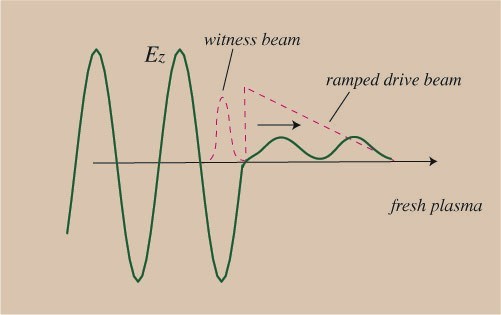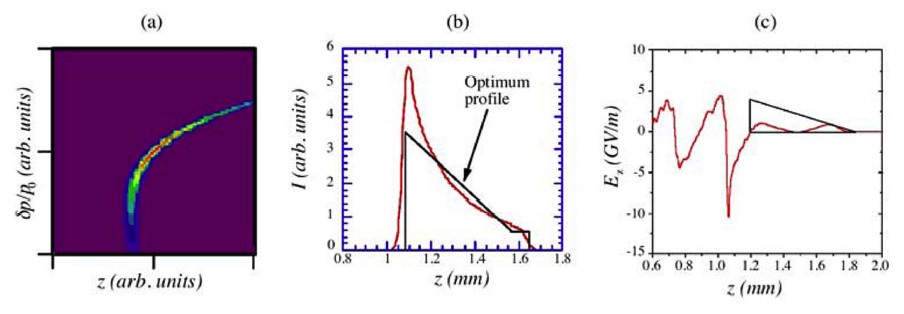Ramped Electron Bunch Experiment
Motivation
The goal of the Ramped Electron Bunch Experiment at the UCLA Neptune Laboratory is to develop a technique for generating bunches of relativistic electrons with a longitudinal distribution that grows in an approximately linear fashion from the head to the tail of the beam, followed by a sharp drop (i.e. the beam current is a triangular ramp in time). Ramped bunches are of interest because they have been determined theoretically to represent the optimal current profile for generating large-amplitude wake-fields in electron beam driven plasma-based accelerators (i.e. the Plasma Wakefield Accelerator or PWFA). In this type of acceleration scheme, a bunch of electrons with energy W (the "drive bunch") is injected into an underdense plasma, exciting a plasma wave which follows behind the driving bunch. This is illustrated by the following figure.

In part (a) of the figure shown below, we see an example of the particle distribution in the phase plane of momentum vs. longitudinal position within the bunch that has been artificially generated to have a profile that approximates the ideal triangular ramp. The ideal current profile (in black) and the profile corresponding to the artificial beam in (a) are shown superimposed in (b). In (c) we see a simulation of the wake-field produced by this beam when injected into a plasma of density 2e16 inverse cubic cm, with a beam charge of 6nC.

The wake-field produced shows a peak electric field of 5 GV/m. By comparison, the electric field gradients in a typical RF cavity based accelerator are on the order of 50 to 100 MV/m. Consequently, if a second electron bunch (the "witness bunch") is injected behind the drive beam, phased near the peak electric field, its energy could in principle be increased by an order of magnitude in a much shorter distance than would be required using a traditional accelerating structure.
To find out how such a beam can be generated, continue to the Background section.
References
1. Seeman, J., IEEE Trans. Nucl. Sci. NS-30, 3180 (1983).
2. Bane, K. L. F., Wilson, P. B., and Weiland, T., "Wake Fields and Wake Field Acceleration," in Physics of High Energy Particle Accelerators, AIP Conference Proceedings 127, 875 (1983).
3. Chen, P., Su, J. J., Dawson, J. M., Bane, K. L. F., and Wilson, P. B., Phys. Rev. Lett. 56, 1252 (1986).
4. Power, J. G., Gai, W., Sun, X., and Kanareykin, A., Proc. PAC 2001, 114 (2001).
5. Bane, K. L. F., Chen, P., and Wilson, P. B., SLAC-PUB-3662 (1985).
6. England, R. J., Rosenzweig, J. B., and Thompson, M., AIP Conf. Proc. 647, 884 (2002).